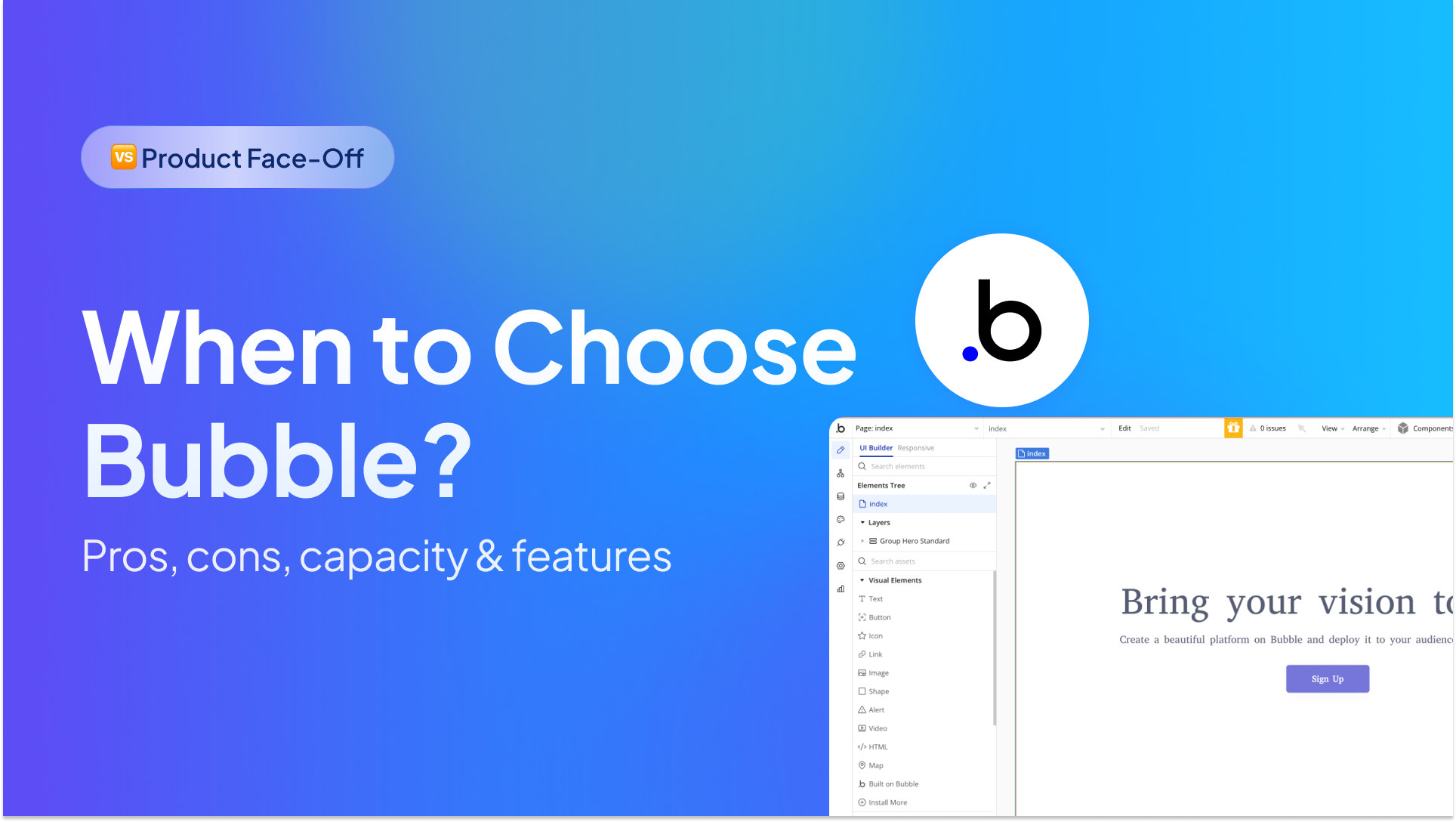Is Bubble.io the Best No-Code Platform for You?

Bubble has emerged as a leading no-code app builder, empowering over 2 million users to create more than 2.3 million applications. Its drag-and-drop editor and robust functionality make it a popular choice for building apps without code. However, despite its reputation as one of the most powerful no-code development platforms, Bubble presents notable limitations. These include restricted scalability, vendor lock-in, and limited flexibility for advanced application development. While its features cater to beginners and small-scale projects, its user experience often falls short for businesses seeking long-term solutions or API-first projects requiring seamless integration with third-party APIs.
Key Limitations of Bubble.io

Vendor Lock-In
Lack of Source Code Export
One of the most significant drawbacks of bubble lies in its inability to export source code. Applications built on this platform remain tied to its ecosystem, leaving users with no option to migrate their projects elsewhere. This limitation restricts businesses from achieving full ownership of their applications. For companies seeking long-term flexibility and control, this lack of portability can pose serious challenges. Unlike some other no-code development platforms, bubble capabilities do not extend to providing developers with access to the underlying codebase, which hinders customization and futureproofing.
Restricted Hosting Options (AWS-only, no private/on-premise hosting)
Bubble.io enforces strict hosting restrictions, allowing deployment only on Amazon Web Services (AWS). It does not support private or on-premise hosting, which limits options for businesses with specific security or compliance requirements. Organizations operating in industries like healthcare or finance, where data privacy is paramount, may find this restriction problematic. The absence of hosting flexibility also makes it difficult for users to optimize costs or tailor hosting environments to their unique needs. This vendor lock-in further reduces the platform's appeal as a no-code saas builder for businesses aiming to scale.
Scalability Challenges
Performance Bottlenecks (e.g., 100 rows/sec database processing)
While bubble markets itself as a scalable solution, its performance often falls short for high-traffic or data-intensive applications. For instance, the platform processes database operations at a rate of approximately 100 rows per second, which pales in comparison to competitors that handle thousands of rows per second. This bottleneck can lead to slow load times and diminished user experiences, especially for applications requiring real-time data processing. Businesses relying on no-code tools for large-scale operations may find these limitations restrictive.
Backend Limitations (JSONB storage, lack of ACID compliance)
The backend architecture of bubble introduces additional constraints. It relies on JSONB storage, which lacks the robustness of traditional relational databases. Furthermore, the platform does not comply with ACID (Atomicity, Consistency, Isolation, Durability) principles, which are critical for ensuring reliable database transactions. These backend limitations make bubble less suitable for applications requiring complex data handling or stringent reliability standards. Developers seeking advanced backend functionality may need to look beyond this no-code app builder.
Pricing Concerns
Workflow Unit-Based Pricing Model
The pricing structure of bubble revolves around workflow units, which measure the number of actions performed within an application. This model can become unpredictable and expensive as applications grow in complexity. Users often find themselves exceeding their allocated workflow units, leading to unexpected costs. For startups and small businesses, this pricing approach can create financial strain, making it harder to manage budgets effectively. Compared to other no-code development platforms, bubble's pricing lacks transparency and scalability.
High Costs for Dedicated Instances ($3,500/month)
For businesses requiring dedicated server instances, bubble imposes a hefty monthly fee of $3,500. This cost far exceeds the budgets of many startups and small enterprises. While dedicated instances offer improved performance and reliability, the high price tag makes them inaccessible to most users. This pricing model highlights a significant gap between bubble's features and its affordability, further limiting its appeal as a long-term solution for no-code app builders.
Limited Customization and Advanced Features
Limited Advanced UI Capabilities
The drag-and-drop editor of bubble simplifies app design, but it imposes constraints on advanced UI customization. Developers seeking to create highly interactive or visually complex applications, such as video games or immersive experiences, may encounter significant roadblocks. The platform's design tools lack the flexibility required for intricate animations or dynamic interfaces. These limitations make bubble less appealing for projects that demand cutting-edge UI capabilities. Competing platforms often provide more robust tools for advanced customization, giving developers greater creative freedom.
Custom Code Restricted to JavaScript
While bubble allows for custom code integration, it restricts developers to using JavaScript. This limitation can hinder teams that rely on other programming languages for specific functionalities or integrations. For example, developers familiar with Python or Ruby may find themselves constrained by the platform's narrow scope. Additionally, the reliance on JavaScript limits the ability to implement certain advanced features, reducing the overall flexibility of the platform. Businesses requiring extensive customization may need to explore alternatives that offer broader coding support.
Why These Limitations Matter
Scalability and Performance
Challenges in Supporting Growing Applications
Scalability remains a critical factor for businesses aiming to expand their digital presence. Bubble, while effective for small-scale projects, struggles to support growing applications due to its inherent limitations. The platform's database processing speed, capped at approximately 100 rows per second, creates significant bottlenecks for high-traffic or data-intensive applications. This constraint directly impacts user experience, as slow load times and delayed responses can frustrate end-users. For businesses relying on no-code tools to handle increasing demands, these challenges can hinder growth and operational efficiency.
Comparison to Competitors (e.g., Momen processes 5000 rows/sec)
When compared to competitors, Bubble's performance and scalability fall short. Businesses prioritizing speed and reliability may find alternatives better suited for their needs. The ability to handle large datasets efficiently ensures smoother operations and a more seamless user experience, making scalability a non-issue for growing enterprises.
Flexibility and Long-Term Viability
Risks of Vendor Lock-In for SaaS Applications
Vendor lock-in poses a significant risk for businesses using Bubble. Applications built on this platform remain confined to its ecosystem, limiting the ability to migrate or adapt to new technologies. For SaaS companies, this lack of flexibility can stifle innovation and create dependency on a single provider. The inability to export source code further exacerbates this issue, leaving businesses vulnerable to changes in pricing or platform policies. Companies seeking long-term viability must weigh these risks carefully before committing to Bubble as their primary no-code app builder.
Lack of Code Ownership and Futureproofing
Code ownership plays a vital role in ensuring the sustainability of digital products. Bubble's features do not grant developers access to the underlying codebase, which restricts customization and futureproofing. This limitation can hinder businesses from adapting their no-code app to evolving market demands or integrating advanced functionalities. In contrast, platforms offering source code export provide greater control and flexibility, enabling businesses to maintain ownership and safeguard their investments against unforeseen changes.
Cost-Effectiveness
Bubble's Pricing vs. Competitors
The pricing structure of Bubble often becomes a pain point for users. Its workflow unit-based model can lead to unpredictable costs as applications grow in complexity. For instance, startups and small businesses may find themselves exceeding their allocated units, resulting in unexpected expenses. In comparison, competitors like Momen offer more transparent and affordable pricing plans. This cost-effective approach allows businesses to scale without financial strain, making it a more attractive option for budget-conscious users.
Financial Burden on Scaling Businesses
Scaling businesses face unique challenges, and Bubble's pricing amplifies these difficulties. The high cost of dedicated server instances, priced at $3,500 per month For many startups, this expense proves unsustainable, forcing them to reconsider their choice of platform.
Comparing Bubble.io to Alternatives

While Bubble has established itself as a prominent player among no-code development platforms, several alternatives offer unique advantages that address its limitations. These alternatives provide enhanced flexibility, scalability, and customization, making them appealing options for businesses seeking long-term solutions. Below is a comparison of Bubble with competitors.
Momen
Superior Backend Performance
Momen distinguishes itself with exceptional backend performance, processing up to 5,000 rows per second. This capability far surpasses the limitations of platforms like bubble, which struggles with database operations capped at approximately 100 rows per second. For businesses managing high-traffic applications or data-intensive workflows, Momen ensures smooth and efficient operations. Its robust backend infrastructure minimizes delays, enhancing user experience and supporting scalability. This level of performance makes Momen a reliable choice for enterprises aiming to handle complex datasets without compromising speed or reliability.
PostgreSQL Database and GraphQL APIs
Momen uses PostgreSQL database, a powerful and widely-used relational database system. This integration provides developers with advanced data management capabilities, including support for structured queries and complex relationships. PostgreSQL's reliability and scalability make it ideal for applications requiring consistent performance under heavy loads. Additionally, Momen offers built-in support for GraphQL APIs, enabling developers to fetch and manipulate data with precision. This feature simplifies the process of building dynamic applications by allowing clients to request only the data they need. The combination of PostgreSQL and GraphQL APIs positions Momen as a versatile platform for modern application development.
Bring-Your-Own-Cloud Deployment Options
Momen offers unparalleled flexibility with its bring-your-own-cloud deployment model. Unlike bubble, which restricts hosting to AWS, Momen allows users to deploy their applications on their preferred cloud providers. This approach empowers businesses to optimize costs, enhance security, and meet specific compliance requirements. Organizations operating in regulated industries, such as healthcare or finance, benefit from the ability to control their hosting environments. By providing this level of customization, Momen ensures that businesses retain full ownership and control over their applications, reducing the risks associated with vendor lock-in.
To dive deeper into the differences between Bubble and Momen, be sure to check out our Bubble vs Softr vs Momen article for a comprehensive comparison.
Wappler
Source Code Export and Private Hosting Options
Wappler stands out as a robust alternative to Bubble due to its ability to export source code. This feature grants developers full ownership of their applications, eliminating the risks associated with vendor lock-in. Businesses can migrate their projects to other environments or modify the codebase as needed, ensuring long-term viability. Additionally, Wappler supports private and on-premise hosting, offering greater flexibility for organizations with strict compliance or security requirements. Unlike Bubble, which restricts hosting to AWS, Wappler allows users to deploy their applications on their preferred infrastructure.
Advanced Customization and Developer Control
Wappler provides unparalleled control over project customization. Developers can integrate custom code in multiple programming languages, enabling the creation of highly tailored solutions. This flexibility contrasts sharply with Bubble, which limits custom code to JavaScript. Wappler also excels in responsive design capabilities, allowing developers to create visually appealing and dynamic user interfaces. For businesses requiring advanced features or intricate designs, Wappler offers a level of control that Bubble cannot match.
WeWeb
Flexible Data Source Integration
One of the standout features of WeWeb is its multiple data source integration. You can easily connect to platforms like GraphQL, Xano, Supabase, PostgreSQL, Airtable, MySQL, and more, allowing for seamless data management and retrieval. In addition, you can integrate with popular APIs such as Stripe, Google Maps, Typeform, and Segment. WeWeb’s versatility in data integrations makes it an excellent choice for more complex applications that require dynamic data flow.
Custom Code Support for Advanced Customization
While WeWeb offers no-code capabilities for building most applications, it also provides the option to add custom CSS and JavaScript when needed. This level of flexibility ensures that developers can go beyond the platform's default capabilities, something that Bubble.io users often request when they need additional customization or more advanced logic. With WeWeb, if you find the no-code properties insufficient for your project’s requirements, you can seamlessly add custom code to get the exact results you're aiming for.
FlutterFlow
Code Export for Full Control
One of FlutterFlow's key advantages over Bubble.io is its ability to export code for mobile apps (iOS, Android, and web). This is particularly useful for developers who want to take their app further by having full control over the codebase after initial development. While Bubble.io is a great choice for no-code app creation, it lacks a built-in feature to export code for mobile apps, which can limit flexibility if you ever need to scale your app beyond Bubble’s hosted environment.
Powerful Third-Party Integrations
FlutterFlow offers seamless integration with a wide range of third-party tools and services, including Firebase, Google Maps, CodeMagic, Stripe, Algolia, GitHub, and even OpenAI. These integrations are essential for building fully functional mobile and web applications. In contrast, Bubble.io’s integration options, while comprehensive, may require additional plugins or workarounds for certain services, making FlutterFlow a more attractive option for developers seeking out-of-the-box integrations.
When Bubble.io Might Still Be a Good Choice
MVP Development
Quick and Cost-Effective Prototyping
Bubble remains a strong contender for Minimum Viable Product (MVP) development. Its intuitive drag-and-drop interface allows entrepreneurs to quickly transform ideas into functional prototypes without requiring extensive technical expertise. This speed-to-market advantage proves invaluable for startups aiming to validate their concepts before committing significant resources. The platform’s visual editor simplifies workflows, enabling users to focus on refining their business models rather than grappling with complex coding challenges. For early-stage ventures, Bubble offers an affordable and efficient way to test ideas and gather user feedback.
Success Stories (e.g., Comet, Beelango, Plato)
Several successful startups have leveraged Bubble to launch their MVPs. For instance, Comet, a freelance marketplace, utilized the platform to build its initial version, which later attracted significant investment. Similarly, Beelango and Plato relied on Bubble to prototype their applications, demonstrating the platform’s capability to support innovative projects. These examples highlight how Bubble empowers entrepreneurs to bring their visions to life, even with limited budgets or technical resources.
Small-Scale Projects
Simpler Micro SaaS Ideas
For small-scale projects or micro SaaS applications, Bubble provides a practical solution. Its extensive plugin marketplace offers pre-built functionalities that simplify the development process. Users can integrate features like payment gateways, user authentication, or analytics without writing custom code. This accessibility makes Bubble ideal for individuals or small teams working on straightforward applications. By reducing the complexity of development, the platform enables creators to focus on delivering value to their target audience.
Projects Benefiting from Bubble's Plugin Marketplace
The plugin marketplace further enhances Bubble’s appeal for small-scale projects. Developers can choose from a wide range of third-party plugins to extend their applications’ capabilities. For example, plugins for email marketing, CRM integration, or social media sharing can be seamlessly added to projects. This ecosystem of tools allows users to customize their applications while minimizing development time. For creators with limited resources, the plugin marketplace provides a cost-effective way to enhance functionality and improve user experience.
Team-Based Development
Git-Like Branching and Merging Capabilities
Bubble supports team-based development through its Git-like branching and merging features. These capabilities allow multiple team members to work on different aspects of an application simultaneously. Developers can create branches to test new features or make changes without affecting the main application. Once the updates are ready, they can merge the branches back into the primary version. This structured approach streamlines collaboration and reduces the risk of errors, making Bubble suitable for teams managing complex projects.
Collaboration Features for Teams
Collaboration tools within Bubble further enhance its usability for teams. Features like real-time editing, role-based permissions, and activity logs ensure that team members can work together efficiently. Managers can assign specific tasks to developers, designers, or testers, ensuring clarity and accountability. These collaboration features make Bubble a viable option for organizations seeking a no-code platform that supports teamwork and project management.
Bubble.io serves as a valuable tool for MVPs and small-scale projects, but its limitations hinder its suitability for long-term business needs. Issues like vendor lock-in, restricted scalability, and unpredictable pricing reduce its competitiveness among no-code development platforms. Alternatives such as WeWeb, and Flutterflow offer superior features and flexibility. For businesses prioritizing backend performance and control, Momen stands out. Its PostgreSQL integration, GraphQL API, and ability to process 5,000 rows per second provide unmatched efficiency. Choosing the right no-code app builders ensures a better user experience and sustainable growth.
See Also
Creating An Affordable No-Code Full-Stack Web App Solution
The Impact of No-Code Development on Companies
Top 10 No-Code Automation Tools for 2025
Our Choice of PostgreSQL for No-Code: Database Insights
Comparing Momen and Bubble: A Detailed Features Analysis
